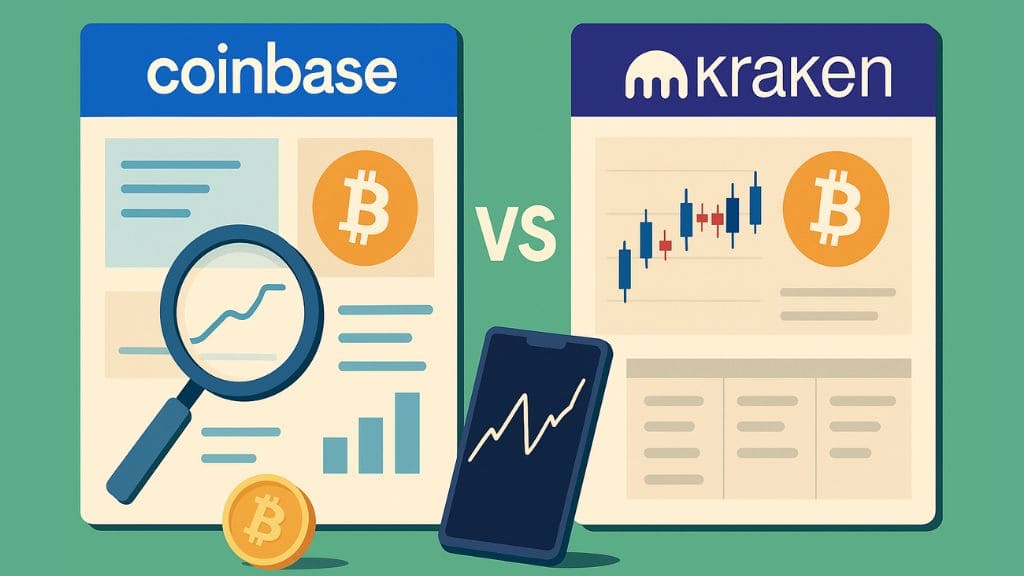Choosing the right cryptocurrency exchange can feel overwhelming. With dozens of platforms competing for your attention, two names consistently rise to the top: Coinbase and Kraken. Both have earned reputations as trusted exchanges, but they cater to different types of traders. Understanding their strengths and weaknesses will help you decide which platform fits your needs.
Getting Started: The First Impression Matters
Coinbase wins the accessibility contest hands down. The platform was designed with newcomers in mind, featuring a clean interface that makes buying your first Bitcoin feel as simple as ordering takeout. You can link your bank account, verify your identity, and make your first purchase within minutes. The mobile app mirrors this simplicity, letting you check prices and trade on the go without confusion.
Kraken takes a different approach. While not complicated, it presents more information upfront, which can feel intimidating if you’ve never traded before. However, this complexity serves a purpose. Experienced traders appreciate having advanced charts, order types, and market data immediately available. The learning curve is steeper, but the payoff comes in the form of powerful trading tools.
Fees: Where Your Money Goes
Fee structures separate casual buyers from active traders. Coinbase charges straightforward fees that vary based on your purchase amount and payment method. Small transactions under two hundred dollars typically incur fees around two to three percent. While convenient, these costs add up quickly if you’re trading frequently.
Coinbase Pro, now integrated into the main platform as Advanced Trade, offers lower fees starting at 0.6% for makers and takers. This appeals to users who want better rates without switching platforms entirely.
Kraken’s fee structure rewards volume. Beginners start at 0.26% for makers and 0.16% for takers, already lower than Coinbase’s standard rates. As your trading volume increases over thirty days, fees drop further. High-volume traders can pay as little as zero percent on maker orders. For anyone planning to trade regularly, these savings become substantial.
Security: Protecting Your Investment
Both platforms take security seriously, but they implement it differently. Coinbase stores roughly 98% of customer funds in offline cold storage, keeping them away from potential hackers. The platform carries insurance on its hot wallet holdings and has never suffered a major security breach affecting user funds. Two-factor authentication and biometric login options add extra layers of protection.
Kraken matches this commitment with its own cold storage system and has maintained a clean security record since 2011. The platform offers advanced security features like a global settings lock, which prevents changes to your account even if someone gains access. You can also set up a master key for additional protection. Kraken’s dedication to security has made it a favorite among privacy-conscious traders.
Cryptocurrency Selection: What You Can Trade
Coinbase lists over 250 cryptocurrencies, covering popular options like Bitcoin, Ethereum, and Solana alongside numerous smaller altcoins. The platform regularly adds new tokens, though its vetting process prioritizes safety over variety. You’ll find most major projects, but some niche tokens might be missing.
Kraken offers around 200 cryptocurrencies with a focus on established projects. While the selection is slightly smaller, Kraken tends to support more trading pairs, giving you flexibility in how you enter and exit positions. The platform also offers futures trading and margin trading for users who want to leverage their positions, something Coinbase doesn’t widely support.
For those who prefer offline transactions, using a crypto ATM provides another option to buy Bitcoin and other major cryptocurrencies with cash. These ATMs have become increasingly common in urban areas, offering an alternative entry point into crypto that doesn’t require an exchange account.
Customer Support: When Things Go Wrong
Customer service reveals another key difference. Coinbase has faced criticism for slow response times and limited phone support. Most issues get resolved through email tickets or the help center, which works fine for simple questions but frustrates users dealing with urgent account problems.
Kraken distinguishes itself with 24/7 live chat support and a reputation for responsive customer service. The platform’s support team can handle complex technical questions and typically responds within hours rather than days. For traders managing significant holdings, this responsiveness provides peace of mind.
Making Your Choice
Your ideal platform depends on your experience level and goals. Complete beginners benefit from Coinbase’s simplicity and educational resources. The platform offers straightforward buying and selling without overwhelming you with options. If you’re investing small amounts occasionally and prioritize ease of use, Coinbase delivers.
Kraken suits traders ready to dive deeper. Lower fees, advanced trading options, and superior customer support make it ideal for anyone planning to trade actively. The initial learning curve pays dividends through better tools and lower costs over time.
Many experienced crypto users actually maintain accounts on both platforms. They use Coinbase for quick, simple purchases and Kraken for serious trading. This approach combines the convenience of one platform with the advanced features of another, giving you flexibility as your crypto journey evolves.
The cryptocurrency landscape continues changing rapidly, and both exchanges adapt to meet user needs. Whether you choose Coinbase, Kraken, or both, you’re selecting from platforms that have proven themselves through years of operation and millions of satisfied users.
Press releases or guest posts published by Crypto Economy have been submitted by companies or their representatives. Crypto Economy is not part of any of these agencies, projects or platforms. At Crypto Economy we do not give investment advice, if you are going to invest in any of the promoted projects you should do your own research.




